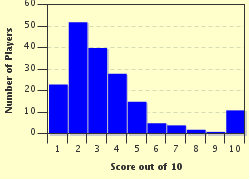Quiz Answer Key and Fun Facts
1. Rodgers and Hammerstein's first collaboration was "Oklahoma!". Name the person (in the original stage version, not the film version) who sings the following line in the title song: "Gonna give you barley carrots and pertaters".
2. For their next collaboration, Rodgers and Hammerstein turned again to a prior source. This time it was Ferenc Molnar's "Liliom", which became "Carousel", arguably one of the most beautiful of their scores, and perhaps the finest. Rather than beginning with a traditional overture, "Carousel" begins with a pantomime scored to "The Carousel Waltz". The vocal score contains the lines that Billy Bigelow would be saying if we actually could hear his "bark" during this sequence. How much does he say a ride on the carousel costs?
3. Rodgers and Hammerstein's third stage collaboration was nowhere near the success that "Oklahoma!" and "Carousel" were. "Allegro" is the story of the life of one man from birth to middle age. Although it was not a success the score still contains some musical gems. "The Gentleman Is A Dope" is a good example. According to the lyric of the song, what two dances is "the gentleman" unable to distinguish between?
4. Next we come to "South Pacific", Rodgers and Hammerstein's fourth stage collaboration. It was based on the book of stories by James Michener entitled "Tales Of The South Pacific". In the first act, Nellie Forbush sings about washing that man out of her hair. What are the names of the two nurses who, besides Nellie, have solo lines in this song?
5. Famed West End and Broadway star Gertrude Lawrence was the catalyst for their next production, "The King And I", based on Margaret Landon's "Anna And The King Of Siam". There is a fun little number that opens the second act of the show that Lady Thiang sings with the other royal wives called "Western People Funny". What are the articles of clothing that are mentioned in the song?
6. After "The King And I", Rodgers and Hammerstein collaborated on a couple of less than successful shows in the mid-fifties. The first of these was an original work called "Me And Juliet" which was an attempt to write an out-and-out musical comedy using music evocative of the "pop" music of the day. One of the numbers, called "Intermission" was sung by the members of the "audience" who are supposedly watching the show-within-the-show. Which of the following celebrities of the day is NOT mentioned in the song?
7. The other of the not-so-successful shows was actually the least successful of any Rodgers And Hammerstein stage music. "Pipe Dream" was based on a John Steinbeck novel called "Sweet Thursday". Bringing Steinbeck's California Cannery Row characters to life on the stage proved somewhat elusive for the duo. Nevertheless, the score is a gem to hear. In the song, "Everybody's Got A Home But Me", what route number does Suzy say she "scooted out of 'Frisco" on?
8. Now we briefly move away from Rodgers And Hammerstein's Broadway shows to the one show they wrote for television: "Cinderella". In the song, "Your Majesties", how many baby lobsters go into the salad?
9. For Rodgers and Hammerstein's eighth stage collaboration they turned to author C.Y. Lee's book about San Francisco's Chinatown, entitled "The Flower Drum Song", dropping the definite article from their title. "Flower Drum Song" contains a song called "A Hundred Million Miracles" that is heard several times throughout the show. Which of the following is NOT one of the "miracles" sung about in the song?
10. Finally, Rodgers and Hammerstein's ninth and final stage collaboration: "The Sound Of Music". Everyone is very familiar with the film version with Julie Andrews, but not quite as many are as familiar with the stage show as they may think. There are marked differences between the two. For example, in the stage version the baroness actually sings! One of the songs she sings is called "No Way To Stop It" and is a trio sung with Max and the Captain. What is the "obvious and simple fact of science" mentioned in the song?
Source: Author
dmnemaine
This quiz was reviewed by FunTrivia editor
agony before going online.
Any errors found in FunTrivia content are routinely corrected through our feedback system.

